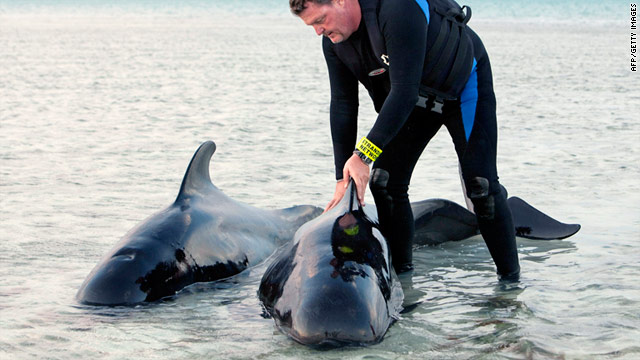Mass pilot whale stranding on Gulf Coast

Marine mammal rescuers continued to work Friday afternoon to nurses the remaining few pilot whales back to health that were stranded in shallow waters off the lower Florida Keys. Of the 18 whales who were stuck in the water, 11 have died, officials said.
“These guys are really weak now,” said Robert Lingenfelser, head of stranding operations for the . “They haven’t eaten in a while, so one of our jobs is to get them re-hydrated and ready for the next step of eating.”
The surviving whales are in stable but guarded condition and are currently corralled in a temporary sea pen. Veterinarians are providing medical evaluations.
The whales were discovered stranded Thursday afternoon in three separate areas in shallow Gulf of Mexico waters near Cudjoe Key. Experts believe the whales are all apart of the same pod.
Officials hope to eventually relocate any surviving whales to Marine Mammal Conservancy‘s rehabilitation facility in Key Largo. Any whales deemed healthy enough will be transported to deeper waters and released, officials said. (NBC Miami)
At least 21 pilot whales were found in an area about 20 miles north of Key West, according to officials with the National Oceanic and Atmospheric Administration. Officials said 13 whales are dead and the count might climb. Several others were being treated at a holding pen at a marina in Cudjoe Key, Florida.
By about 4 a.m. Friday a team of about 50 people were able to get six of the whales into the safer area and were protecting them with a sea pen they had created. The whales were spread out in about a four-mile area in waters that were as shallow as three inches in some areas. The situation for the animals was dire because mass strandings can be a sign of some kind of sickness in some of the whales. Also, being stuck in shallow waters makes them vulnerable to predators.
Adult pilot whales can measure up to 20 feet long and weigh up to 3 tons. Due to their social nature, they are often involved in mass strandings, according to the American Cetacean Society. Wet sheets were placed over the whale’s bodies in an effort to block the sun and cool them.
Officials say that determining the exact number of whales stranded is difficult because of the tides.
A similar incident occurred in the Florida Keys in 2003, when 28 whales were stranded. Most of them died, but after several months of care, five were released back into the ocean. Last year, dozens of pilot whales died in northern New Zealand after 58 of them were stranded on a remote beach. (CNN)

kathy commented on The Watchers:
how about pollution??? SO much pollution with the Gulf spill, continuing spills in the Gulf and other areas around the world where these animals end up beached….
More results of the toxic chemicals used to break down the oilspill from Deepwater Horizon ? Indeed, sad both for them the fish and marin life itself 🙂
So many cases of this happening lately with whales and sardine shoals. Do you think it maybe linked with geomagnetic activity? if a a graph overlay of geomag activity and recorded whale/fish events were done might it generate interesting results?
Sad read. 🙁 Poor guys. 🙁